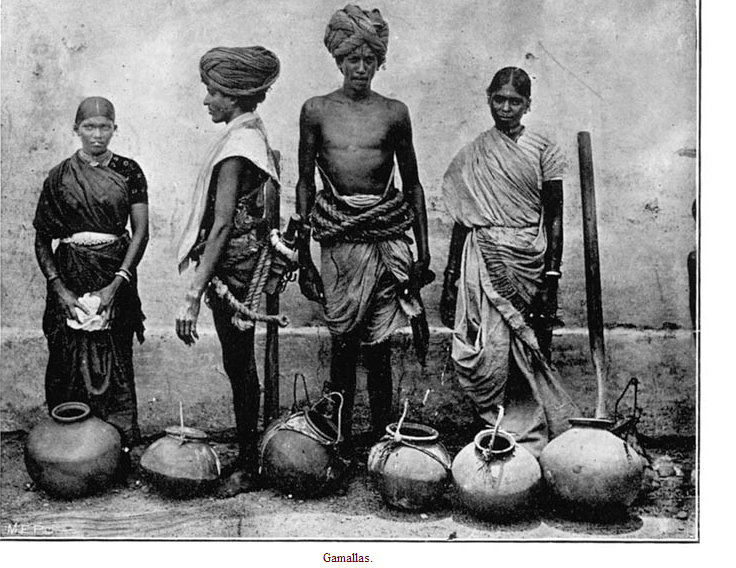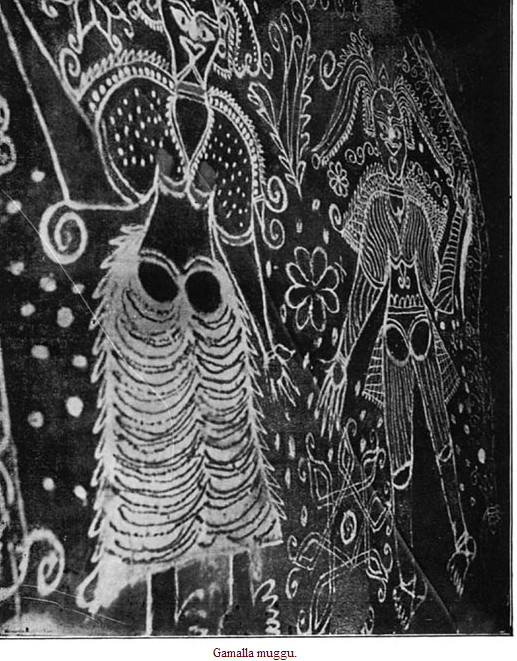Gamalla
This article is an excerpt from Government Press, Madras |
Gamalla
The Gamallas are a class of toddy-drawers, and distillers and vendors of arrack in the Telugu country and are supposed to be Īdigas who have bettered themselves, and separated from that caste. Both Gamallas and Īdigas worship the deity Kāttamayya. At the census, 1891, some returned Īdiga as their sub-division. In the Cuddapah district some toddy-drawers style themselves Asilivāndlu. Possibly the Īdiga, Gamalla, and Asili toddy-drawing classes only represent three endogamous sections of a single caste. In the Nellore district, the toddy-drawers style themselves Gamandla or Gavandlavāndlu, and say that they have one gōtra Kaumandlapu or Gaumandlapu. It is probable that the name Gamandla or Gavandla has been coined by Brāhman purōhits, to connect the caste with Kaumandala Mahārishi of the Purānas. The Gamallas say that they were created to draw toddy by the sage Kavundinya, and that they belong to the Gaundla varnam (caste). I am informed that a Purānam, called Gamandla or Gamudi Purānam, has been created. In the social scale, the toddy-drawers appear to occupy a higher position in the Telugu than in the Tamil country, and they are sometimes said to be Telagas or Balijas, who have adopted toddy-drawing as a profession. The more prosperous members of the community are toddy and arrack (liquor) shop-keepers, and the poorer members extract toddy from the palm-trees.
The Kāpus of the Nellore district employ Gamallas as their cooks and domestic servants, and all menial service and cooking are done by Gamallas in the houses of Kāpus on the occasion of festivals and marriages. Concerning the origin of the Gamallas, the following legend is current. A Rishi was doing penance by standing on his head, and, like the chamæleon, living on light and air, instead of food. According to some, the Rishi was Kaumandla, while others do not know his name. An Īdiga girl passed by the Rishi, carrying a pot filled with toddy, which polluted the air, so that the Rishi could not continue the penance.
Being struck with the girl’s beauty, he followed her to her home, and pointed out to her that she was the cause of his mishap. He asked her to become his wife, but she announced that she was already married. Eventually, however, they became secretly united, and, in consequence, the whole town caught fire. The girl’s husband, returning home with some toddy, was amazed at the sight, and she, to protect him, hid the Rishi in a vat. Into this vat the husband poured the toddy, which made the Rishi breathe hard, so that the toddy, for the first time on record, began to foam. Noticing this, the husband found a lingam, into which the Rishi had been transformed. This lingam was worshipped by the Gamandlas, and they are at the present day Saivites.
Like other Telugu castes, the Gamallas have exogamous septs, such as parvathāla (hills), kudumalu (a cake), annam (cooked rice), and pandhi (pig). Among gōtras, the following may be noted:—kavundinya, kārunya, vāchalya, and surāpāndēsvara (surā pānda, toddy pot). Marriage is, as a rule, adult, and remarriage of widows is permitted, though the tendency at the present day is to abandon the practice. At the wedding of a widow, the bottu (marriage badge) is tied round her neck at night. Prior to the marriage ceremony, the worship of female ancestors must be performed. A new female cloth, betel, and flowers, are placed on a tray, and worshipped by the mothers of the contracting couple. The cloth is given as a present to a sister or other near relation of the bride or bridegroom.
The dead are cremated, and the widow breaks one or two of her bangles. Fire must be carried to the burning-ground by the father of the deceased, if he is alive. On the day following cremation, the hot embers are extinguished, and the ashes collected, and shaped into an effigy, near the head of which three conical masses of mud and ashes are set up. To these representatives of Rudra, Yama, and the spirit of the departed, cooked rice and vegetables are offered up on three leaves. One of the leaves is given to the Jangam, who officiates at the rite, another to a washerman, and the third is left, so that the food on it may be eaten by crows.
All, who are assembled, wait till these birds collect, and the ashes are finally poured on a tree. On the ninth, tenth, or eleventh day after death, a ceremony called the peddadinam (big day) is performed. Cooked rice, curry, meat, and other things, are placed on a leaf inside the house. Sitting near this leaf, the widow weeps and breaks one or two of the glass bangles, which she wears on the wrist. The food is then taken to a stream or tank (pond), where the agnates, after shaving, bathing, and purification, make an effigy of the dead person on the ground. Close to this cooked rice and vegetables are placed on three leaves, and offered to the effigy. The widow’s remaining bangles are broken, and she is presented with a new cloth, called munda koka (widow’s cloth) as a sign of her condition. All Gamallas, rich or poor, engage on this occasion the services of Māla Pambalas and Bainēdus (musicians and story-tellers) to recite the story of the goddess Ankamma.
The performance is called Ankamma kolupu. Some of the Mālas make on the ground a design, called muggu, while the others play on the drum, and carry out the recitation. The design must be made in five colours, green (leaves of Cassia auriculata), white (rice flour), red (turmeric and lime), yellow (turmeric), and black (burnt rice-husk). It represents a male and female figure (Vīrulu, heroes), who are supposed to be the person whose peddadinam is being celebrated, and an ancestor of the opposite sex. If the family can afford it, other designs, for example of Ankamma, are also drawn. On the completion of the muggu, cocoanuts, rice, and betel are offered, and a fowl is sacrificed. Like many other Telugu castes, the Gamallas have a class of beggars, called Eneti, attached to them, for whom a subscription is raised when they turn up.
The Gamallas are mostly Saivites, and their priests are Ārādhya Brāhmans, i.e., Telugu Brāhmans, who have adopted some of the customs of the Lingāyats. They worship a variety of gods and goddesses, who include Pōtharāju, Kātamayya, Gangamma, Mathamma, and Thallamma, or Thadlamma. Once or twice during the year, a pot of toddy is brought from every house to the shrine of Thallamma, and the liquor contained in some of the pots is poured on the floor, and the remainder given to those assembled, irrespective of caste.
At the festival of Dīpāvali, the celebrants bathe in the early morning, and go, in wet clothes, to an ant-hill, before which they prostrate themselves, and pour a little water into one of the holes. Round the hill they wind five turns of cotton thread, and return home. Subsequently they come once more to the ant-hill with a lamp made of flour paste. Carrying the light, they go thrice or five times round the hill, and throw into a hole therein split pulse (Phaseolus Mungo). During the whole of this day they fast. On the following morning they again go to the hill, pour milk into it, and snap the threads wound round it.
At the festival of Sankarānthi, the principal member of every family observes the worship of ancestors. Various articles are placed in a room on leaf plates representing the ancestors, who are worshipped by the celebrant after he has been purified by bathing. Taking a little of the food from each leaf, he places it on a single leaf, which is worshipped, and placed in the court-yard, so that the crows may partake thereof. The remainder of the food is distributed among the members of the family. At the census, 1901, some Gamallas returned themselves as Settigādu (Chetti).

